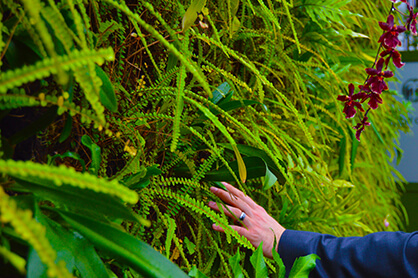Defining Biophilia: How we connect with nature

Green building means integrating biophilia into design.
Biophilia is the foundation of all we do at Planterra. And the same might be said for most professionals in the interior landscaping industry. Wondering what it is?
What is Biophilia?
Biophilia is an innate connection to nature and the living systems. Social Psychologist Eric Fromm coined the term biophilia in 1964 and it was popularized 20 years later by Biologist Edward Wilson By the 1990s the Green Building Movement showed links between nature and improved environmental quality, health, and productivity.
At its core, biophilia describes a healing connection with nature. When we spend an overabundance of our time indoors or in urban areas, we lack this connection. And without it, without the chance to walk through the grass, breathe clean air, listen to the calming sound of waves crashing against the shore, one’s quality of life can be depleted.
Biophilia can inform how customers, visitors or employees feel when they enter any building. An opportunity to connect with the natural world can make a person feel more comfortable in that environment.
"Plants and nature have a calming effect on people, whether they realize it or not,” President Shane Pliska of Planterra told Oakland County Prosper. “When someone is anxious, they're less likely to be productive at the office or to want to come back to a restaurant, and they may not even know why.”
Do you sense nature in your surroundings?
Biophilia engages all of our senses. You experience this condition when you walk through the rustle of fallen leaves in autumn, and when you hear birds chirping outdoors in the spring. It’s evident when you add indoor plants to a room and experience a healthy, cleaner quality of air. The smell of fresh soil and blooming flowers or the feel of a cool breeze can improve our mood, calm our minds or invigorate our senses. This feeling is not restricted to the outdoors.
At a time when humans spend 90 percent of our time indoors, the concept of biophilia and ways to design it back into architecture can help us retain these direct and indirect benefits we gain from connecting with nature.
Designing with biophilia in mind
The biophilic design represents a love of place. And each design must be made to suit the location at hand.
Adding a living wall or creating an indoor plantscape can provide all of the benefits – right indoors. Designing with this in mind can be as simple as adding nature-themed artwork or as elaborate as adding an indoor fountain. Skylights that bring in natural light and indoor plants that naturally remove known pollutants are all ways to bring Biophilia to your surroundings.
Pliska has long been interested in the study of biophilia and how it can impact the lives of those around us. He regularly speaks at conferences on its importance. Pliska believes biophilia adds value to a building itself.
"This value of nature can be seen in the cost of real estate,” he explained to Oakland County Prosper. “A high rise, for example, costs more if there is a view of nature. This is a universal value. The shopping industry has a huge amount of data on this subject and how nature influences consumers. Grocery stores, for one, heavily study plants and music and lighting. It's why you'll almost always find flowers and the produce section when you first walk in. It's a feeling of I'm in a Garden of Eden."
Biophilic design is considered an essential way to mitigate stress and improve the quality of our lives. Find out more about biophilia and how it can enhance lives by contacting Planterra.
Planning a project? Contact us.
Project Contact
For information on events visit the Planterra Conservatory website
